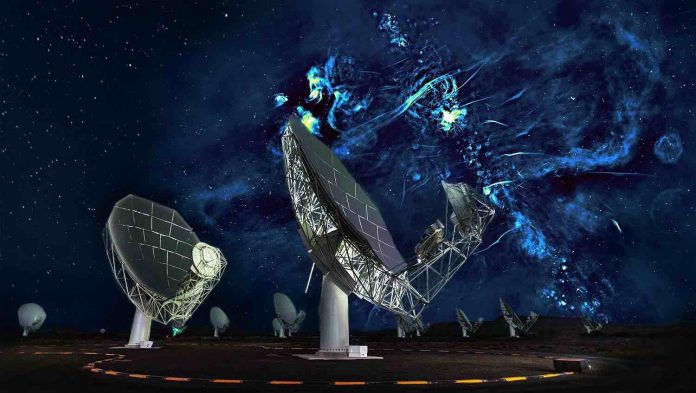The centre of our galaxy has blown some bubbles. Astronomers using the MeerKAT telescope in South Africa have discovered a pair of enormous bubbles of high-energy particles looming hundreds of light years above and below the Milky Way’s central supermassive black hole.
The bubbles appear to have been created by a high-energy event that punched into the interstellar medium above and below the galactic centre sometime in the past few million years.
One possibility is that the triggering event was an outburst from the black hole at the center of our galaxy, created by a surge in the amount of matter falling into it.
Another, says William Cotton, a radio astronomer at the US National Radio Astronomy Observatory, and a member of the discovery team, is that the energy may have come from a burst of star formation in the region around the galactic centre, with a resulting surge in supernova explosions.
All told, Cotton says, the amount of energy was on the order of the Sun’s energy output over its entire lifetime. “It’s a lot of energy.”
Meanwhile, he adds, the discovery of the bubbles has helped resolve a 35-year-old mystery.
In 1984, radio astronomers spotted long filaments of high-energy radio emissions, extending outward from the galactic centre.
“They’re magnetic tubes that are filled with very high-energy electrons which cause them to radiate,” Cotton says. But the source of these electrons had been unknown.
The new images, however, show that the filaments are closely associated with the bubbles, suggesting that they stem from the same underlying event. “Almost all of the more than 100 filaments are confined by the radio bubbles,” says another member of the discovery team, Farhad Yusef-Zadeh, of Northwestern University, US.
The newly discovered features may also be related to another galactic phenomenon known as Fermi bubbles, Cotton says.
These are much larger and much more energetic, emitting gamma rays, rather than radio waves. “[But] it’s possible the bubbles we’re seeing are ‘baby’ versions [of these],” he says. Or perhaps they somehow feed into the larger Fermi Bubbles. “We don’t really know.”
The dramatic new observations were made possible in part because they were made at a new radio telescope observatory in South Africa, called MeerKAT, which is better located to study the galactic centre than are more-northerly observatories.
In the Northern Hemisphere, the galactic centre is low in the southern sky and only above the horizon for a few hours per day, says Fernando Camilo, MeerKAT’s chief scientist. “You only have three or four hours to observe it, and you’re pointing near the trees at the horizon.”
But MeerKAT is at 31 degrees south latitude, “so the galactic centre goes right overhead,” Camilo says.
MeerKAT also has an unusually large number of radio dishes, with 64 of them spread out in an eight-kilometre-wide array.
“The more dishes you have, the higher the fidelity of the images you make,” Camilo says. In fact, he adds, image quality increases with the square of the number of telescopes in the array.
“That helps to make a high-quality image, especially of extended structures with diffuse emissions. That really made a huge difference in detecting these bubbles.”















